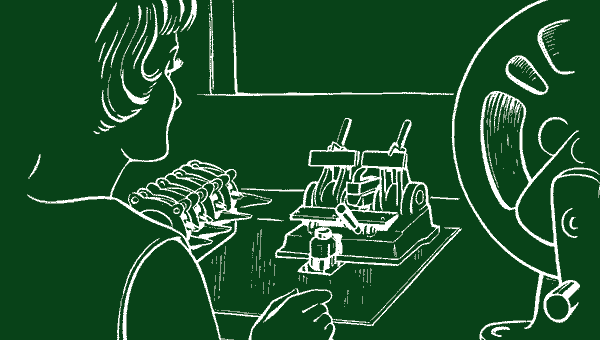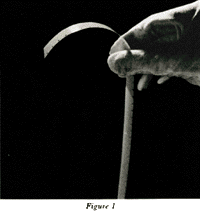
(EDITOR'S NOTE: Although this article is intended primarily for the beginning
editing student, it can also be helpful for experienced people who want to
improve their splicing techniques. Thank you to the Small Movies web site for this
terrific article)

- The first step in learning to splice is to learn to tell the emulsion side
of film from the base side.
- Hold the film up to the light and rotate it slightly. When the light
hits the BASE side of the film, it will bounce off brightly because the the
base is the SHINY side of the film. The emulsion is the DULL side and
usually has less gloss or shine to it when light is reflected on to it.
(Fig. 1)
- Although the base of any film stock will be shinier than its emulsion,
it is often difficult to tell one from the other on fillms with
glossy-looking emulsions - e.g. Ektachrome Commercial and fresh frome the
can lightstruck positive use throughout the industry for leader.
In this
case, the best way to tell emulsion from base is to hold up a short piece of
film and look at its curl. (Fig. 1). The emulsion side of the film will be
on the inside of the curl.
- If these two methods should failthe emulsion side can always be
determined by moistening your lower lip and placing the film against it. The
EMULSION side will stick to your lip but the base side will not.
CAUTION:
The emulsion side will also pull the skin off your lip if you do not moisten
your lip well. Never use is method unless all else fails and never use the
moisture test on original film. Grease and water cannot be removed from the
original.
Always use the first two methods whenever possible. When you
put the film in your mouth to determine emulsion position, you immediately
brand yourself as a non-professional.
- Learning to handle the film by its only is the next important step toward
splicing. Film is handled by its edges to avoid getting grease and dirt from
your fingers on it. Never pick up film or handle it with your fingers flat on
its surface. This rule applies even when you are wearing gloves. Placing your
fingers flat on the film is a sure sign of an amateur.
When you have
learned to tell emulsion from base and have mastered the techniques of
handling film by the edges only, you are ready to learn the mechaniques of
splicing.
- Any discussion on how to splice must begin with the splicer itself. The
tool may vary from a small table model with a single scraper and without heat
to a complicated foot splicer with all the latest innovations. But the basic
components are all the same.
Since one of the the most widely used splicers
today is Maier-Hancock 8mm-16mm portable hot splicer originally marketed by
Bell and Howell, we will use this splicer as our demonstration model.



 Film Collector's
Reference Center
Film Collector's
Reference Center